|
|
|
|
|
|
|
|
|
|
|
|
|
|
|
|
|
|
|
|
|
|
|
|
|
|
|
|
|
|
|
|
Growing Biodynamic Onions
|
|
|
|
|
|
|
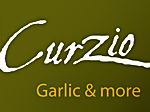 |
|
|
|
Dear Friends:
This page is designed to inform you on my method of growing onions. Onions are part of my daily diet as I cook 2-3 bulbs every morning for breakfast. Plus I eat onion greens, flowers and roots.
The "working horse" of my garden is the variety Copra, which is harvested in August and keeps in my kitchen pantry (without refrigeration) till July. |
|
|
|
|
|
|
|
In this newsletter you will learn about growing onions. |
|
|
|
|
|
|
|
|
|
|
|
|
|
Copra Onions in April ... watch for spoilage ... still edible with some discarding. Later, much later, all the way to July, you will find some green growth. I peel the onion, discarding just the dry leaves ... all the rest is still very good.
What a gift from Nature. A root that is still edible one year after harvesting ... without wasting resources on refrigeration. |
|
|
|
|
|
|
|
|
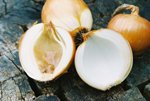 |
|
|
|
|
|
|
|
|
|
|
In 2007 I run out of onions and ate the last few bulbs on July 4th - if I had more bulbs left, I guess, I could have 2006 Copra onions till the end of July. Just on time for the first 2007 onion crop. Going full circle without purchasing onions! |
|
|
|
|
|
|
|
March to early April ... time to transplant |
|
|
|
|
|
|
|
|
|
|
|
|
|
Order seedlings ... much faster than onion sets.
I like to put the bare root seedlings in a compost tea for a few days before transplanting. Hopefully you can catch a window of snow-bare soil just before the last big snow fall at the end of the winter. |
|
|
|
|
|
|
|
|
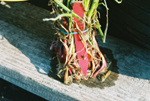 |
|
|
|
|
|
|
|
|
|
|
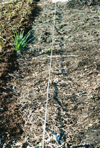 |
|
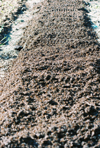 |
|
|
|
|
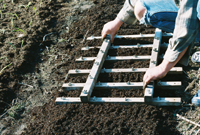 |
|
|
|
|
|
|
|
|
|
|
In early April the soil is still free on any growth. My biodynamic gardening method leaves the soil untouched [no tilling] and prevents unwanted vegetation with plenty of dry leaves layering. With a string I pull a straight line and cover about two feet with 1 - 2 inches of compost. A wooded tool marks the 6 x 6 inches spacing.
This is the spacing that I like for seedlings to develop into a large size bulb. Obviously you can inter-plant ... double the density if you want to pull seedlings early and use as green onions. |
|
|
|
|
|
|
|
|
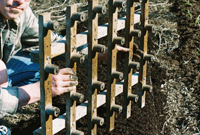 |
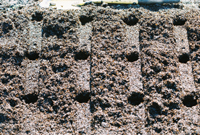 |
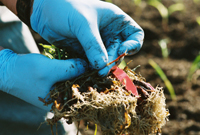 |
|
|
From the bunch of seedlings select the larger ones - about the size of a pencil, down to half of that - but seedlings that are smaller ... like the one I'm holding in the picture above, discard it as it would be a waste of time transplanting. |
|
|
|
|
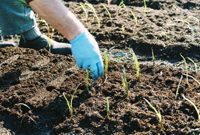 |
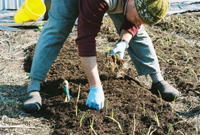 |
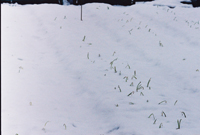 |
|
|
I use a straight-rod weeder to poke deeper holes through the 1 inch compost layer into the underlaying soil, insert the seedling and close the hole with the compost mulch. I pray for snow or light rain ... as my biodynamic philosophy does not allow watering.
No watering means that the seedling now has to work harder to go find moisture deeper in the soil. It will grow a deeper root-system, mine more trace elements, increase the flavor and nutritional value of the plant! |
|
|
|
|
In May and June harvest green onions |
|
|
|
|
|
|
|
|
|
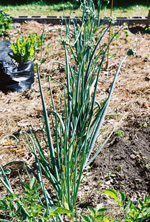 |
|
These onions are grown expressly for use as greens. They are known as Egyptian Onions or Walking Onions. Seed available from SSE. I've got some from my 96 year old neighbor - she tells me that her Pfeifer grand-parents grew these same onions starting around 1850 in Fort Atkinson, WI - she's still using the same seed saved year after year for over 150 years.
The special feature of this onion variety is the growth of seed on top of the leaves (top setting bulbs). The plant keeps growing larger seed an the flow of juices keep the leaves green much longer than other varieties of onions. It propagates by letting the top seed fall on the soil, thus little energy is put into developping a large bulb. |
|
|
|
|
|
|
|
|
|
|
|
|
|
|
|
|
|
|
|
|
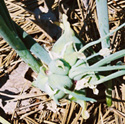 |
|
|
|
|
|
|
|
|
|
|
|
|
|
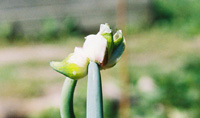 |
|
|
|
|
|
|
|
|
|
|
|
When you harvest the green onions for your summer salads, keep the top seed in a cool dry place and you can reseed wherever and whenever during the year. The seed is very hardy ... you can drop it on the soil even in very late fall before the first snow fall. Keep some in your garden shed all winter and plant in the spring and through the summer, so you have a supply of green onions for most of the year.
Or leave a few onions in the ground and let them walk!
NOT REALLY! You don't want to let the plant do that. In the picture above you see a clump of seed grown on top of a leaf that gravitation took down to the soil. You can count about 8 - 10 seeds in this clump. You don't want 10 onions to grow in the same spot. Therefore it is better to harvest the seed. Let it dry out a little and separate.
Space the seed about 2 inches apart in a row. |
|
|
|
|
In July - August harvest shallots and bulb onions |
|
|
|
|
|
|
|
|
|
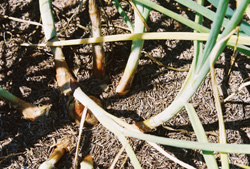 |
|
|
|
|
|
|
|
|
|
|
|
|
|
|
|
|
|
|
|
|
In July 2007 I'm still eating shallots that I have harvested in July 2006 - just keep them in a cool , dark place (no refrigeration required).
This picture was taken July 1st ... yes, it is too early to harvest for storage. You can start enjoying shallots for fresh consumption, but need to wait until all leaves are dry to harvest for storage. Wait after a few days without rain and keep in a well ventilated area to fully cure. |
|
|
|
|
Even when all leaves are dry the root system is still pulling minerals into the bulbs. So be patient and let the bulb cure in the soil. You will be rewarded with longer shelf life. |
|
|
|
|
|
|
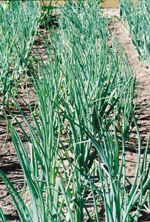 |
|
A row of onions in early July. I keep pulling "unwanted vegetation" to avoid competition. Remember to thank each plant you pull ... for the minerals that have been mined for your top soil improvement.
In the past I would spread dry leaves between the onion bulbs to prevent more "unwanted vegetation growth" ... now I prefer to pull it and leave the bulbs growing out of the soil exposed to the sun. This improves the curing and extends the shelf life. |
|
|
|
|
|
|
Copra Onion at early July bulbing stage |
|
|
Burgermeister Onion at early July bulbing stage |
|
|
|
|
|
|
|
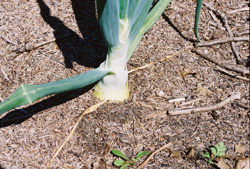 |
|
|
|
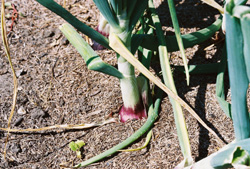 |
|
|
|
|
|
|
|
|
|
|
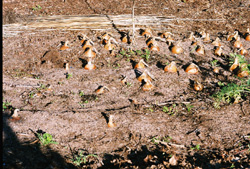 |
|
|
|
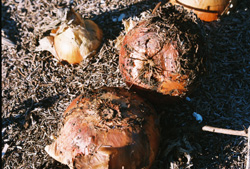 |
|
|
|
|
|
|
|
|
The bulbs grow on the surface and the compost mulch keeps the unwanted vegetation at bay. You must wait until the green leaves have turned completely dry. Rotate a bulb and notice how the roots have fallen off: this a well cured bulb, ready for dry storage. I don't use refrigeration and still can keep these onions till at least the end of June.
Once the bulbs are harvested, I hand-pull the few plants that have germinated between the rows and cover the whole area with leaves that I have collected the last fall.
The garden is now ready for the next crop rotation. |
|
|
|
|
In September transplant winter onions |
|
|
|
|
|
|
|
|
|
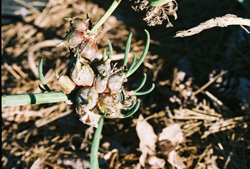 |
|
|
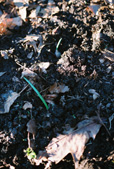 |
|
|
|
|
|
|
|
|
|
|
|
|
|
|
|
Scroll down to October to see a picture of this new row of Walking Onions. |
|
|
|
|
|
|
|
|
I took these pictures at the end of August. You find the Walking Onions that are still green and supporting the little bulbils on top of the leaves.
The weight of the bulbils is dragging the leaves near the soil for its natural progression.
This is the best time to harvest the bulbils and transplant them in a row, spaced a few inches apart. You should transplant the bulbils that have started the germination of the green leaves at this time. If you find bulbils that have not germinated yet, store them for later transplanting 2 - 3 weeks apart. Enjoy green onions through the winter. |
|
|
|
|
In September get more greens with propagation by stooling |
|
|
|
|
|
|
|
|
|
|
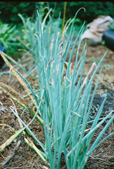 |
|
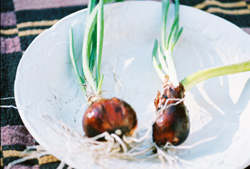 |
|
|
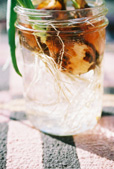 |
|
|
|
|
|
|
|
On the left you see the same row of Egyptian green onions that you have already seen in the picture above, taken in May. By now we have bulbs in the ground; the top set bulbs have been removed and replanted. From mid September I harvest bulbs that are forcing a flush of new greens (definition of propagation by stooling).
Notice on the picture in the middle: the bulb on the right side in the dish has small green growth coming out of the top and large stem to the right. The large stem to the right is the old growth that had the top-set bulbs; it is too hard to eat.
The new growth is delicious, especially in September when nobody has fresh green onions. By keeping the harvested bulbs in water, I preserve the quality of the roots until ready to cook. So, I remove the skin and the hard stem, but eat the white bulb, the fresh greens and the roots. Go find onion roots in my breakfast garbage plate. |
|
|
|
|
In October mulch your Egyptian Onion Greens |
|
|
|
|
|
|
|
These onions are very, very hardy and will keep growing through the winter. Heavy mulching is not necessary! But you will obtain longer white stems on your winter greens if you mulch them with lots of straw. |
|
|
|
|
|
|
|
|
|
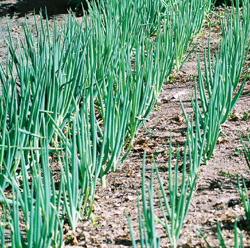 |
|
Well, I forgot to mulch but I am very impressed with the size of the Great-Grandma Pfeifer strain of Egyptian onions. In this picture taken at the end of May you see three rows, of which the first and second are GGma Pfeifer's while the third row is a different strain.
I'm planning to reoffer the seed through SSE and build a web page just for this variety and heirloom strain. |
|
|
|
How to save onion seed. |
|
|
|
|
|
|
|
Onions are difficult to start from seed!!! How many times have you seen "crop failure" on web sites that offer seedlings in the spring. That's why you want to learn how to save seed yourself. Onions cross pollinate with any variety - even with wild ones ... to keep pure varietes, remove all flower stalks of any onion - except the variety you want to grow for seed. Onions are biennials - the seed stalk is supposed to grow the second year!
If you see the seed stalk during the first year ... that's a sign of a poor quality plant of which you don't want to save the seed. In the spring replant about 15 - 20 bulbs that you have overwintered for the purpose of growing seed stalks.
Harvest the seed as soon as the seed is mature. Pay attention not to leave the seed too long on the stalk and harvest on a sunny day to keep the seed dry.
|
|
|
|
|
Go visit these pages if you are curious about these onions
|
|
|
|
|
Do you have any family and friends that would like to receive our newsletter?
Forward this link; it will take them to the free subscription page.
http://www.curzio.com/N/subscribe.htm
If you need help subscribing please drop us a note; we can do that for you.
We hope you enjoy receiving our newsletter and will forward it to your friends and family. We appreciate your help in spreading the word about our activity.
Looking forward to meet you at the Kenosha HarborMarket this Saturday, or some day.
Your friend will be under the white tent,
Curzio
|
|
|
|
|
|
|
|
|
|
|
Go to our home page - more recipes - Ask a question
|
|
|
|
|
|
|
|
|


























